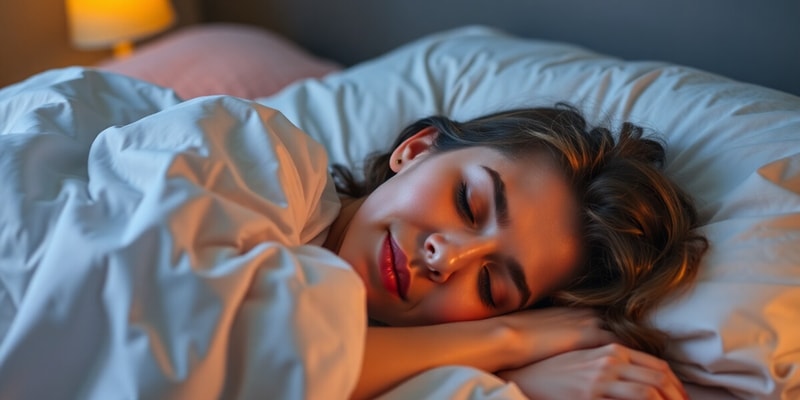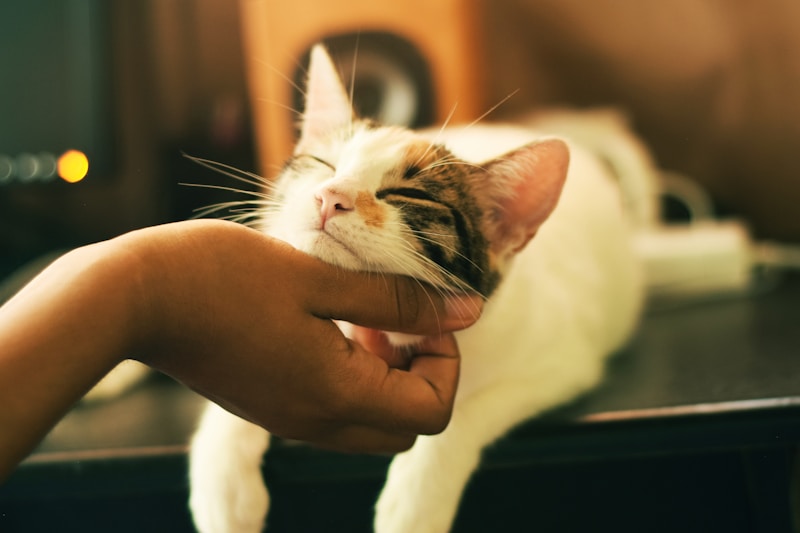Podcast
Questions and Answers
What happens to the thalamus during NREM sleep?
What happens to the thalamus during NREM sleep?
Which neurotransmitter partly activates the brainstem during REM sleep?
Which neurotransmitter partly activates the brainstem during REM sleep?
Which of the following parts of the brain is deactivated during REM sleep?
Which of the following parts of the brain is deactivated during REM sleep?
What is the primary consequence of having no sensory input during NREM sleep?
What is the primary consequence of having no sensory input during NREM sleep?
Signup and view all the answers
What kind of waves are present in the brain during REM sleep?
What kind of waves are present in the brain during REM sleep?
Signup and view all the answers
What is the main purpose of assigning infants to different groups in the memory task study?
What is the main purpose of assigning infants to different groups in the memory task study?
Signup and view all the answers
Which of the following statements is true regarding the infants who napped?
Which of the following statements is true regarding the infants who napped?
Signup and view all the answers
What finding related to sleep spindles and memory enhancement was reported in the studies?
What finding related to sleep spindles and memory enhancement was reported in the studies?
Signup and view all the answers
What was the duration after which the napping group showed better performance in the spatial memory task?
What was the duration after which the napping group showed better performance in the spatial memory task?
Signup and view all the answers
What was the unique aspect of the 'napped with PSG' group in Kurdziel et al.'s study?
What was the unique aspect of the 'napped with PSG' group in Kurdziel et al.'s study?
Signup and view all the answers
In the imitation task, how was memory determined for the infants?
In the imitation task, how was memory determined for the infants?
Signup and view all the answers
What was the outcome for infants who did not take a nap after learning?
What was the outcome for infants who did not take a nap after learning?
Signup and view all the answers
Which age group was studied in the research related to enhancing learning through naps?
Which age group was studied in the research related to enhancing learning through naps?
Signup and view all the answers
What benefit did napping provide to students tested 5 days after a lecture?
What benefit did napping provide to students tested 5 days after a lecture?
Signup and view all the answers
How long was the lecture that students attended before the memory test?
How long was the lecture that students attended before the memory test?
Signup and view all the answers
What was the design of the nap condition in the study?
What was the design of the nap condition in the study?
Signup and view all the answers
What percentage of memory performance decrease was observed in non-nap students one day after the lecture?
What percentage of memory performance decrease was observed in non-nap students one day after the lecture?
Signup and view all the answers
What finding was concluded regarding students who took naps after the lecture?
What finding was concluded regarding students who took naps after the lecture?
Signup and view all the answers
What was the purpose of the pretest given to students?
What was the purpose of the pretest given to students?
Signup and view all the answers
What was the main suggestion made by the study regarding the role of napping?
What was the main suggestion made by the study regarding the role of napping?
Signup and view all the answers
Which group of students remembered roughly the same amount of information on a test 5 days later?
Which group of students remembered roughly the same amount of information on a test 5 days later?
Signup and view all the answers
What is the main function of the electroencephalography (EEG) in polysomnography?
What is the main function of the electroencephalography (EEG) in polysomnography?
Signup and view all the answers
Which stage of sleep is characterized by sleep spindles and K-complexes?
Which stage of sleep is characterized by sleep spindles and K-complexes?
Signup and view all the answers
What does REM sleep paralysis prevent?
What does REM sleep paralysis prevent?
Signup and view all the answers
What is the primary role of zeitgebers in circadian rhythms?
What is the primary role of zeitgebers in circadian rhythms?
Signup and view all the answers
What happens to sleep timing following sleep deprivation according to the two-process model?
What happens to sleep timing following sleep deprivation according to the two-process model?
Signup and view all the answers
Which process primarily governs alertness and arousal according to the two-process model?
Which process primarily governs alertness and arousal according to the two-process model?
Signup and view all the answers
Which sleep stage shows the most synchronized brain activity?
Which sleep stage shows the most synchronized brain activity?
Signup and view all the answers
What is a key characteristic of phasic REM sleep?
What is a key characteristic of phasic REM sleep?
Signup and view all the answers
What type of sleep is more prevalent at the end of a sleep cycle?
What type of sleep is more prevalent at the end of a sleep cycle?
Signup and view all the answers
What impact does jet lag have on cognitive function?
What impact does jet lag have on cognitive function?
Signup and view all the answers
Who were the first researchers to demonstrate the endogenous nature of circadian rhythms in humans?
Who were the first researchers to demonstrate the endogenous nature of circadian rhythms in humans?
Signup and view all the answers
The suprachiasmatic nucleus (SCN) is primarily responsible for regulating which aspect of sleep?
The suprachiasmatic nucleus (SCN) is primarily responsible for regulating which aspect of sleep?
Signup and view all the answers
How does melatonin influence sleep-wake cycles?
How does melatonin influence sleep-wake cycles?
Signup and view all the answers
What happens to the total amount of sleep as age increases?
What happens to the total amount of sleep as age increases?
Signup and view all the answers
Which statement accurately describes the function of adenosine in sleep regulation?
Which statement accurately describes the function of adenosine in sleep regulation?
Signup and view all the answers
How does caffeine affect the signal of adenosine?
How does caffeine affect the signal of adenosine?
Signup and view all the answers
At what age do individuals typically transition to monophasic sleep according to the described sleep architecture?
At what age do individuals typically transition to monophasic sleep according to the described sleep architecture?
Signup and view all the answers
Which group is likely to experience the most awakening during sleep?
Which group is likely to experience the most awakening during sleep?
Signup and view all the answers
What sleep pattern is observed in newborns?
What sleep pattern is observed in newborns?
Signup and view all the answers
Why might someone feel better around 11 AM after sleep deprivation?
Why might someone feel better around 11 AM after sleep deprivation?
Signup and view all the answers
Which of the following statements best describes the effects of REM sleep on creativity?
Which of the following statements best describes the effects of REM sleep on creativity?
Signup and view all the answers
How do sleep patterns transform from newborns to adults?
How do sleep patterns transform from newborns to adults?
Signup and view all the answers
Which of the following is a characteristic of sleep architecture in children around 7 years old?
Which of the following is a characteristic of sleep architecture in children around 7 years old?
Signup and view all the answers
Study Notes
Measurement of Sleep
- Types of sleep measurement:
- Phenomenology: Focuses on subjective experiences, including loss of awareness, disorientation, thoughts, and dreams.
- Behavior: Observes physical states like horizontal position, muscle tone, circadian rhythm impact, and responsiveness.
- Physiology: The most reliable method involving brain and body changes.
Polysomnography (PSG)
- Electroencephalography (EEG): Monitors brain's electrical activity, capturing brain waves.
- Electrooculography (EOG): Records eye movement voltage fluctuations.
- Electromyography (EMG): Measures muscle activity, typically from the chin and face.
Sleep Stages
-
NREM Sleep Stages:
- Stage 1: Transition to sleep.
- Stage 2: Characterized by sleep spindles and K-complexes, significant for memory consolidation.
- Slow-Wave Sleep (SWS): Includes Stages 3 and 4, notable for deep restorative sleep.
-
REM Sleep: Identified by PGO waves, essential for dreaming, and includes mechanisms to prevent physical acting out of dreams (REM paralysis).
Sleep Cycle Characteristics
- A typical cycle of NREM followed by REM lasts approximately 90 minutes.
- First half of sleep primarily consists of deep NREM, while the latter half contains more REM sleep.
- Hypnogram: A visual representation of sleep architecture.
Circadian Rhythms
- Defined as biological rhythms occurring over a 24-hour cycle, influenced by environmental factors or zeitgebers.
- Different types of rhythms:
- Diurnal: Active during the day.
- Nocturnal: Active at night.
- Crepuscular: Awake during twilight times.
- Ultradian: Shorter than 24-hour cycles within sleep.
- Infradian: Longer than 24-hour cycles (e.g., menstrual cycle).
Role of Zeitgebers
- External cues that synchronize internal clocks, such as light, food, and physical activity.
- Light is the primary zeitgeber critical for resetting the circadian rhythm.
Health Implications
- Circadian disruptions can lead to cognitive deficits and hormonal imbalances.
- Increased cortisol levels and slower reaction times found in individuals with disrupted circadian patterns.
Processes Influencing Sleep
- Process S: Represents sleep debt, favoring NREM sleep accumulation with prolonged wakefulness.
- Process C: Governed by circadian clocks, influences alertness and sleep cycle timing.
Historical Context
- Circadian rhythms first demonstrated in plants by Jean Jacque d'Orto de Mairan in 1729.
- Human studies by Kleitman and Richardson in 1938 showed that sleep-wake patterns can persist in the absence of light.
Brain Activity During Sleep
- In NREM, brain activity is synchronized and slow; sensory processing is diminished.
- REM is marked by active brain regions related to emotions and visual processing, despite the deactivation of the prefrontal cortex that impairs logical reasoning.
Biological Functions of Circadian Rhythms
- Regulate bodily functions and optimize health; peak medication efficacy often coincides with circadian highs.
- Master clock is located in the suprachiasmatic nucleus (SCN) of the hypothalamus, which controls various physiological processes.
Impact of Sleep Deprivation
- Results in increased sleep pressure, resulting in enhanced NREM and overall sleep duration in subsequent sleep opportunities.
- Evening melatonin release promotes readiness for sleep onset.
Conclusion
- Understanding sleep processes and rhythms enhances knowledge of health, cognitive functioning, and sleep-related disorders.### Memory and Napping in Infants
- Infants participating in memory tasks were split into baseline and learning groups, each with nap and no nap conditions.
- The memory task involved imitation of puppet actions to assess recall.
- Significant learning was observed in infants who napped, with better memory retention beyond 24 hours.
- Infants who napped immediately after learning performed better than those who did not nap.
Spatial Memory in Preschool Children
- Preschoolers (3-5 years) were tested on spatial declarative memory tasks, with three groups: napped, awake, and napped with PSG (polysomnography).
- Napping after learning improved recall performance, with significant differences persisting after 24 hours.
- Increased NREM sleep spindles correlated with improved memory recall, indicating a role in memory consolidation.
Napping Effects on Middle School Students
- Middle school students who napped for two hours after a lecture performed better in memory tests compared to those who remained awake.
- Participants were tested before and after a lecture, with memory assessed 1, 2, and 5 days later.
- Napping enhanced memory retention significantly over time, particularly at the 2 and 5-day marks.
Sleep Patterns Across Lifespan
- Sleep architecture varies significantly through different life stages:
- Newborns exhibit polyphasic sleep, evolving into monophasic sleep by adulthood.
- Total sleep hours decrease with age, while deep REM sleep patterns change as individuals mature.
- Children experience more deep REM sleep and fewer awakenings compared to adults.
Two Process Model of Sleep-Wake Regulation
- Process C (circadian rhythm) regulates the drive to be awake; as this increases, so does alertness.
- Process S (homeostatic sleep drive) builds as time awake increases, leading to a stronger need for sleep.
- Caffeine interferes with the adenosine signaling linked to Process S, temporarily masking fatigue.
- Sleep deprivation reveals a cyclical pattern of alertness and fatigue throughout the day, influenced by the interplay of Processes C and S.
Creativity and Sleep
- Historical anecdotes suggest a link between sleep and creativity, such as Paul McCartney's inspiration and Thomas Edison's napping habits.
- Notable figures in science (e.g., Mendeleev) have leveraged sleep for creative breakthroughs.
- Empirical studies indicate that REM sleep enhances problem-solving abilities, with participants benefiting from sleep rather than staying awake.
Sleep Architecture in Different Ages
- Children (~7 years) exhibit more slow-wave sleep with few awakenings.
- Young adults (~25 years) experience deep NREM sleep in the first half of the night and more REM sleep later on.
- Elderly individuals (~75 years) show reduced slow-wave sleep, increased awakenings, and diminished REM sleep.
Studying That Suits You
Use AI to generate personalized quizzes and flashcards to suit your learning preferences.
Related Documents
Description
Test your understanding of the Psychology of Sleep in this Midterm quiz for Psych 133 at UC Berkeley. This quiz covers sleep basics, including measurement and types of sleep phenomena. Prepare to evaluate your knowledge before the exam!




